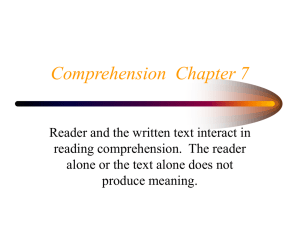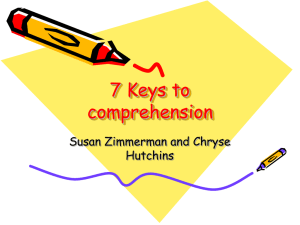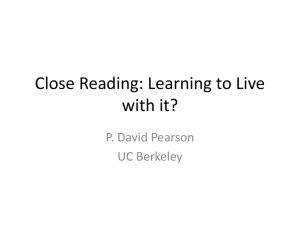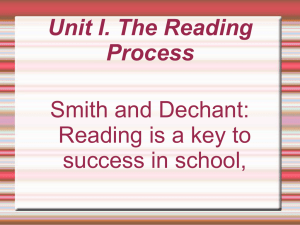Name: REINALYNE F. IGNACIO & ANGELYN ALACBAY Subject
advertisement
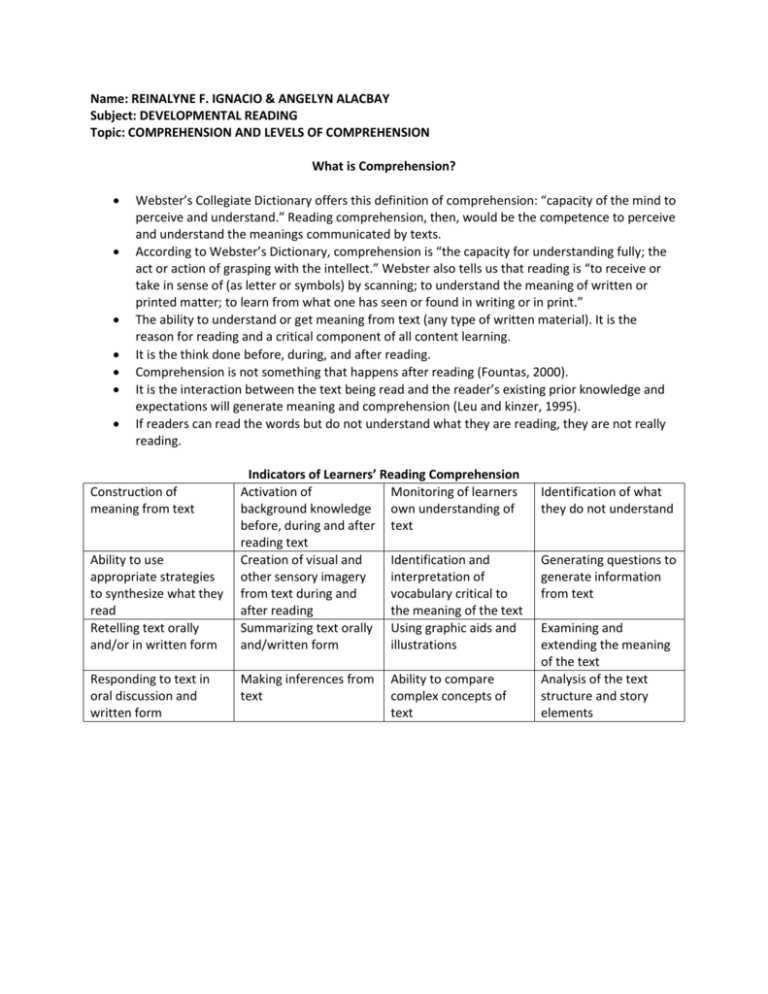
Name: REINALYNE F. IGNACIO & ANGELYN ALACBAY Subject: DEVELOPMENTAL READING Topic: COMPREHENSION AND LEVELS OF COMPREHENSION What is Comprehension? Webster’s Collegiate Dictionary offers this definition of comprehension: “capacity of the mind to perceive and understand.” Reading comprehension, then, would be the competence to perceive and understand the meanings communicated by texts. According to Webster’s Dictionary, comprehension is “the capacity for understanding fully; the act or action of grasping with the intellect.” Webster also tells us that reading is “to receive or take in sense of (as letter or symbols) by scanning; to understand the meaning of written or printed matter; to learn from what one has seen or found in writing or in print.” The ability to understand or get meaning from text (any type of written material). It is the reason for reading and a critical component of all content learning. It is the think done before, during, and after reading. Comprehension is not something that happens after reading (Fountas, 2000). It is the interaction between the text being read and the reader’s existing prior knowledge and expectations will generate meaning and comprehension (Leu and kinzer, 1995). If readers can read the words but do not understand what they are reading, they are not really reading. Construction of meaning from text Ability to use appropriate strategies to synthesize what they read Retelling text orally and/or in written form Responding to text in oral discussion and written form Indicators of Learners’ Reading Comprehension Activation of Monitoring of learners background knowledge own understanding of before, during and after text reading text Creation of visual and Identification and other sensory imagery interpretation of from text during and vocabulary critical to after reading the meaning of the text Summarizing text orally Using graphic aids and and/written form illustrations Making inferences from text Ability to compare complex concepts of text Identification of what they do not understand Generating questions to generate information from text Examining and extending the meaning of the text Analysis of the text structure and story elements Comprehension Levels The levels of comprehension, or complexity of thinking, are presented in the following hierarchy from the least to the most sophisticated level of reading. LEVEL Description Question Asked Common questions used to illicit this This level is knowing what is type of thinking are who, what, when, actually stated which includes and where questions. These are the facts and details, rote learning easiest to answer because the answer is and memorization. expressed directly. This level involves surface understanding only. At the literal level of Level One comprehension, readers are at LITERAL the most basic of levels. Readers are building their knowledge but they do not necessarily have command of it. When they first approach brand new information, readers are at the literal level of comprehension. The types of questions asked are open The reader gleans what is ended, thought-provoking questions like implied or meant, rather than why, what if, and how. The answers to what is actually stated. these questions are not directly stated. This level involves drawing One is asked to analyze and think about inferences or reading between what he has read and to use his the lines. background knowledge about the Readers tap into prior subject to answer the question. knowledge/experience and attach new learning to old information. Readers make logical leaps and Level Two educated guesses. INTERPRETATIVE Readers read between the lines to determine what is meant by what is stated. At this level, readers are attempting to understand what the author meant by what he/she said in the story, paragraph or textbook. It is presumed that they have already memorized certain facts at the literal level and now they are attempting to see the implications of the author’s words. Level Three APPLIED At this level, readers are attempting to understand that which they memorized at the literal level of comprehension. This involves taking what was said(literal) and then what was meant by what was said (interpretive) and then extend (apply) the concepts or ideas beyond the situation. Readers analyze or synthesize information and apply it to other information. At this level the reader or student Can attempt to answer this question: How would the author’s message apply to other situations given what you memorized and understood at the other two levels? Readers are attempting to elevate or raise their thinking one more “notch” or level to a more critical, analyzing level. This presumes that they have already reached the previous two levels. They are “reading between the lines” and then examining the message from the author and attempting to apply that message to other situations. Common questions may include In what ways…If these are…If you were… These questions ask one to go beyond literal and interpretive reading by applying the information one has just read to another similar or familiar situation. 1. 2. 3. 4. 5. 6. 7. 8. 9. 10. 11. 12. Skills that are Important for Comprehension Understand the words Comprehend what the words Find facts and details Seek one or more pieces of information in the text Find main ideas From the whole content, prioritize the overriding (primary) theme or idea Figure out the sequence Tell the order or events Find cause-effect See how one person, action, or event triggers another; also, identify the “who” or “what” that occurs Make inferences Develop ideas or images based on what is read in the text but do not stated Generalize Discern the relationship between single events and the larger situation or other events Identify tone/mood Sense how the author was feeling and how he wanted the reader to feel while reading Identify “theme” See the “big picture” moral or abstract idea Identify characterization Comprehend what makes characters act as they do Distinguish fact from fiction Sort out what is real and what is part of the imaginary world created by the author Find bias or propaganda Notice obvious or hidden bias Cognitive Factors that Affect Reading Comprehension Reader interest/Motivation for Reading Schema Waxier (2004) claims that “we cannot downplay the role that student interest and motivation play in constructing meaning.” Readers read for several reasons, e.g. for pleasure, knowledge generation and many other reasons. However, we must consider the materials that are appealing and interesting to them. In reading, there are two general motivation orientations. These are: Intrinsic – engagement in a reading activity by choice and for its own sake; deep involvement that fulfills a desire to learn or know. Extrinsic – engagement in a reading activity for the purpose of receiving some external, usually surface level reward or recognition, such as praise or positive evaluation, or avoidance of punishment; desire to complete the reading task rather than understand it This is distinctly personal store of knowledge gained through a lifetime of experiences. This stored knowledge along with its storage structure is called schemata. This term is often used in its singular form - schema – that refers to an organized lump of knowledge or experience, often coupled with feelings or emotions associated with experience at the time the information was stored. When readers have little or no schema for a subject, comprehension is greatly impeded. Schema is often compared to the filing system our brain uses catalog information the files on a computer and the storage system by which those files are organized in the computer’s memory. This theoretical construct of cognitive structure again argues for reading as a meaning making activity that is unique to the individual. Comprehension does not proceed independently of a reader’s fund of related experiences and background knowledge or schemata. Schema theory was developed by R. C. Anderson, a respected educational psychologist. This learning theory views organized knowledge as an elaborate network of abstract mental structures which represent one’s understanding of the world. SIL international (1999) maintains that analyzing the Schema Theory leads us to realize that: It is important to teach general knowledge and generic concepts. A large proportion of learner difficulties can be traced to insufficient general knowledge, especially in cross-cultural situations. Teachers must help learners build schemata and make connections between ideas. Discussion, songs, role play, illustrations, visual aids, and explanations of how a piece of knowledge applies are some of the techniques used to strengthen connections. Since prior knowledge is essential for the comprehension of new information, teachers either need to: - Help students build the prerequisite knowledge; or - Remind them of what they already know before introducing new material. Schemata grow and change as new information is acquired. Learners feel internal conflict if they are trying to assimilate schemata which contradict their previous suppositions. Teachers need to understand and be sympathetic to this tension. Deep-seated schemata are hard to change. An individual will often prefer to live with inconsistencies rather that to change a deeply-held value or belief. Another important concept related to the development of fluent reading is that of metacognition or metacognitive awareness. Simply stated metacognition is knowing about knowing, thinking about thinking. Metacognition is knowing “what we know” and “what we don’t know.” The basic metacognitive strategies are: Connecting new information to former knowledge. Selecting thinking strategies deliberately. Planning, monitoring, and evaluating thinking processes. Metacognition A thinking person is in charge of his behavior. When he employs metacognition, he does the following: Determines when it is necessary to use metacognitive strategies; Selects strategies to define a problem situation and researches alternative solutions; Tailors this search for information to constraints of time and energy; monitors, controls and judges her thinking; Evaluates and decides when a problem is solved to a satisfactory degree or when the demands of daily living take a temporary or permanent higher priority; Metacognitive reflection questions could include: What was expected to do? What part of this process/assignment were difficult, and why? If I were to do this over again, what would I do differently? What are some connections between learning this and other subjects? How does what I have learned relate to other things I do? What are some examples of what I did well/ how has this problem helped me become a better problem-solver? Which vocabulary and comprehension strategies best work for me?
